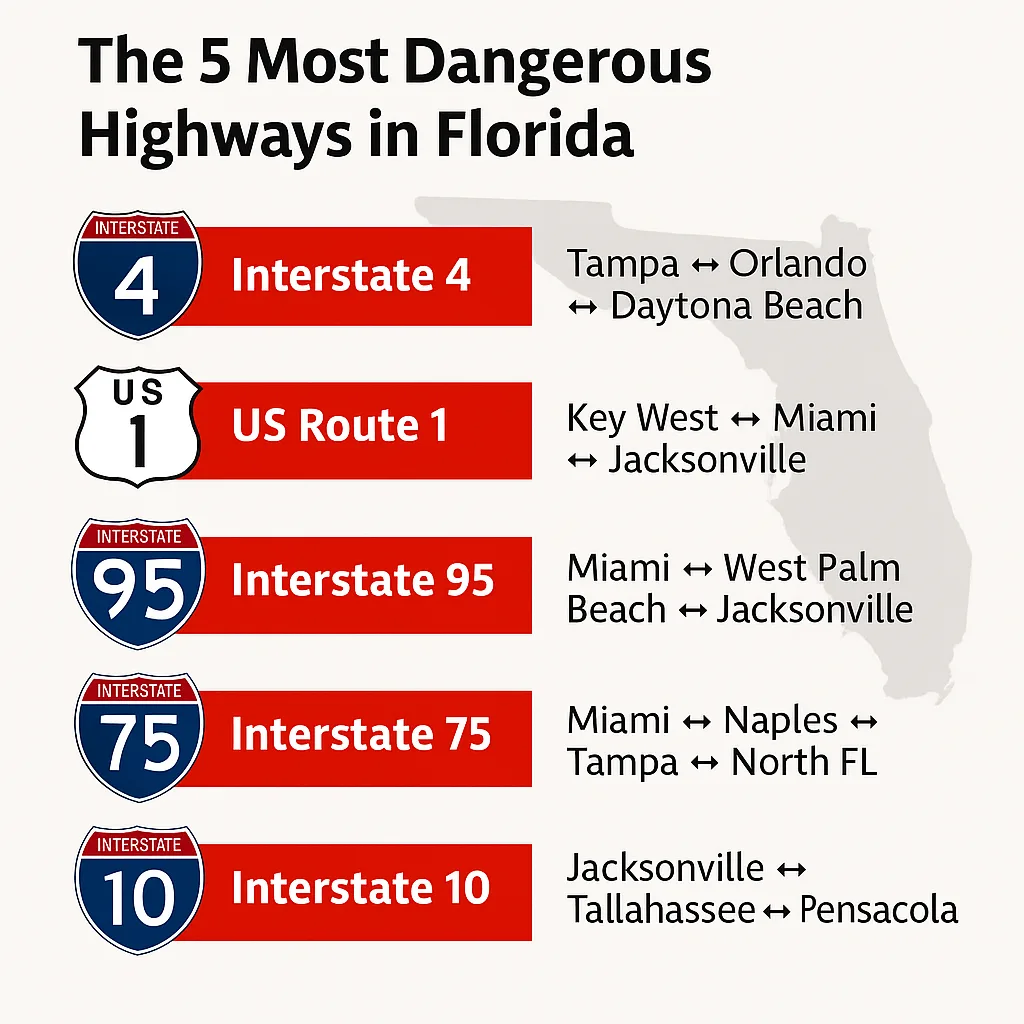When people picture Florida, they think about beaches, sunshine, and road trips — not trauma, injury, and wrecked cars. But if you’ve spent any time on our roads, you know the truth: Florida’s highways are some of the deadliest in the country.
In 2023 alone, over 800 people died on Florida’s interstates, according to the latest federal report. That’s more than nearly every other state, and the majority of those deaths happened in urban areas, right here in places like Miami, Tampa, Fort Lauderdale, and Jacksonville.
Florida’s Fatal Crash Statistics
According to the latest data from the Highway Statistics Series of the Federal Highway Administration, Florida saw 2,547 lives lost in motor vehicle crashes in 2023. Of those, 92 fatalities occurred on interstate highways, and the vast majority happened on rural and urban roads like Miami, Tampa, and Jacksonville. In fact, Florida now ranks third in the nation for urban interstate fatalities after Texas and California.
Let’s look at the deadliest roads in Florida based on crash data.
The 5 Most Dangerous Highways in Florida
Florida has 12 active interstate highways covering nearly 1,500 miles. Some are long-distance routes like I-4 and I-75. Others are short city connectors like I-275 or I-395. But the common theme? They’re dangerous. Really dangerous.
1. Interstate 4 (I-4)
Route: Tampa ↔ Orlando ↔ Daytona Beach
I-4 has been the number one deadliest highway in the United States for a few years, reported by Teletrac Navman, in a row. It’s fast, congested, and full of tourists. It cuts through major tourist hubs, filled with theme park traffic, hotel exits, and sudden construction.
Common crash factors:
- Distracted tourists
- Aggressive local drivers
- Construction detours
- Lane confusion and sudden merges
2. US Route 1 (US-1)
Route: Key West ↔ Miami ↔ Jacksonville
This coastal route looks like paradise, but in the Miami area, it turns deadly. In one recent year alone, over 250 DUI-related fatal crashes happened here.
Why it’s risky:
- Nightlife and drunk driving
- Beach-bound tourists
- Busy intersections with limited visibility
- Pedestrians and cyclists
3. Interstate 95 (I-95)
Route: Miami ↔ West Palm Beach ↔ Jacksonville
Florida’s busiest highway — and one of its most dangerous.
In 2023, Florida reported 718 deaths on urban interstates, and I-95 runs through every major East Coast metro.
Why it’s risky:
- Congestion
- Road rage
- Speeding semis
- Wrecks during rush hour or rainstorms
4. Interstate 75 (I-75)
Route: Miami ↔ Naples ↔ Tampa ↔ North FL
Nicknamed “Alligator Alley”, I-75 slices through the Everglades and into Tampa and beyond. It’s long, fast, and packed with trucking traffic — making it a hotspot for multi-vehicle crashes and fatal rollovers.
Hazards include:
- Tire blowouts
- Wildlife crossings
- Flooded lanes
- Speeding trucks and tailgaters
5. Interstate 10 (I-10)
Route: Jacksonville ↔ Tallahassee ↔ Pensacola
Don’t let the open road fool you — rural highways like I-10 still see hundreds of deaths annually. When crashes happen here, they’re often severe due to:
- High-speed head-on collisions
- Drowsy or fatigued drivers
- Limited lighting and long EMS response times

Florida’s Other Deadliest Roads You Shouldn’t Overlook
Most people only think of I-4 or I-95 when it comes to Florida’s traffic trouble. But the danger doesn’t stop there. Some of the shorter, urban connector roads in Florida are just as risky.
These roads often fly under the radar, but they’ve become hotspots for serious crashes, including rear-end collisions during heavy traffic, dangerous merging zones where lanes end abruptly, pedestrian-related accidents near busy crosswalks, and last-minute turns from lost or distracted tourists trying to navigate unfamiliar exits.
I-275 – Tampa Bay’s Most Overloaded Interchange
Where it runs: Tampa ↔ St. Petersburg
This highway connects I-75 with downtown Tampa and over the bay to St. Pete. It’s home to some of the most accident-prone interchanges in Florida, especially on the I-4 & I-275 junction near Ybor City and on the Howard Frankland Bridge during rush hour. Crashes here are common due to sudden lane merges, confusing signage, and tourist congestion heading to downtown attractions or Clearwater Beach.
I-295 – Jacksonville’s High-Speed Danger Loop
Where it runs: Beltway around Jacksonville
I-295 loops around the entire Jacksonville metro, giving drivers a fast bypass — and a false sense of safety. In reality, it’s a hotspot for high-speed crashes, aggressive weaving during rush hour, fatal crashes involving semi-trucks. With major connections to I-95 and SR 9A, this highway often sees multi-vehicle wrecks and delayed emergency response in its northern stretches.
I-195 & I-395 – Causeway Chaos in Miami
Where they run:
- I-195: Midtown Miami ↔ Miami Beach
- I-395: Downtown Miami ↔ MacArthur Causeway
These short Miami expressways are vital routes to South Beach, Biscayne Boulevard, and the entertainment districts. They become deadly during major events, holiday weekends, or rainstorms. The Risk factors are also distracted drivers and pedestrians near the exits and speeding on elevated ramps.
I-595 – Broward County’s Hurricane Evacuation Speed Trap
Where it runs: Fort Lauderdale ↔ I-75 / Alligator Alley
This short connector may seem harmless — but it’s been the site of several multi-car pileups, especially near downtown exits. Tourists heading to Pensacola Beach and Naval Air Station add to the confusion. Most common crash causes are confusing exits downtown, speeding on the curved ramps, rear-end collisions in backed-up beach traffic.
I-110 – Pensacola’s Forgotten Risk Zone
Where it runs: Downtown Pensacola ↔ I-10
This short connector may seem harmless — but it’s been the site of several multi-car pileups, especially near downtown exits. Tourists heading to Pensacola Beach and Naval Air Station add to the confusion.
Why These Roadways Are So Dangerous
Distracted driving habits, unfamiliar drivers on the road, and weather all affect Florida roads being dangerous for drivers.
Distracted Driving
Distracted driving habits like texting while driving is heavily monitored around the U.S and many states have a campaign to help reduce it. In July 2019, Florida’s law to ban texting while driving went into full swing and included using social media like Snapchat as illegal as well. In 2019, there were over 56,000 total crashes that were directly related to drivers being distracted as they drove and 271 resulted in fatalities. Using your phone while driving causes you to look away from the road and down to your device. If you are driving at high speeds, like on a highway, your vehicle will cover a lot of roadway while you aren’t paying attention.
Unfamiliar Drivers
During heavy tourist months like March to April for spring break and June to July for summer, the rate of accidents significantly goes up in Florida. The dangerous Florida roadways we mentioned earlier become the deadliest roads during these peak months with an increase of fatalities per mile. March continuously sees the most fatal car accidents in Florida, especially in regards to drunk driving accidents. In popular college spring break locations, like Miami, Daytona Beach, and Tampa, it is important to practice safe driving and be aware of your surroundings.
Weather
From June to September, the rainy weather in Florida is the most unpredictable and hazardous for most out-of-state drivers who aren’t comfortable driving in the rain. Heavy rain makes it difficult for drivers to see in front of them, so it is recommended to slow down when driving. Since Florida is very close to sea level, flooding is a frequent occurrence after heavy rains. To avoid flooding hazards like hydroplaning, AAA says it’s better to move away from the right lane when water starts pooling. AAA also advises that if your vehicle shuts down in standing water do not restart it.
Highway Safety Tips for Florida Drivers
Florida highways can be unpredictable — one moment you’re cruising, and the next, traffic comes to a dead stop or the skies open up with heavy rain. Here are a few smart tips to help you avoid becoming another statistic.
- Keep a safe following distance. Tailgating is one of the top causes of highway crashes — especially when traffic suddenly slows down.
- Avoid distractions. That text, call, or app can wait. Keep your eyes on the road and hands on the wheel.
- Use turn signals early. Let other drivers know what you’re doing before you change lanes or exit.
- Watch for merging traffic. High-speed on-ramps and exits can be dangerous if you’re not alert.
- Slow down in bad weather. Rain hits hard in Florida, and highways flood fast. Reduce your speed and watch for standing water.
- Stick to the center lane when possible. It often provides the best visibility and distance from merging cars and fast-moving semis.
- Give trucks extra space. Avoid their blind spots and never cut in front of them — they can’t stop quickly.
- Pull over if you’re drowsy. Long stretches like I-75 and I-10 can be exhausting. If you’re tired, get off the road.
- Turn on headlights in low visibility. It’s not just safer — it’s the law during rain.
- Stay calm. Aggressive driving escalates quickly and leads to avoidable accidents.
Highway crashes happen fast , and they’re often serious. But with just a few smart habits, you can lower your risk every time you hit the road. And if someone else’s mistake puts you in danger, let’s look at what you need to do right after the crash.
What to Do After A Florida Car Accident
If you or someone you love was injured in a highway wreck, here’s what to do next:
- Call 911 immediately. Report the accident and ask for police and EMS. On highways, fast-moving traffic makes it harder for other drivers to see you — so emergency lights and backup are essential.
- Stay in your vehicle if it’s unsafe to exit. If you’re on a multi-lane highway or near a blind curve, it may be safer to remain inside with your seatbelt on until help arrives.
- Move to the shoulder, if possible. If your car is drivable, carefully move to the nearest safe shoulder or emergency lane to avoid secondary collisions.
- Document everything. Take photos or video of the scene, vehicle damage, road signs, skid marks, debris, and your injuries. These details can disappear quickly on a highway.
- Get medical treatment immediately. Even if you “feel fine,” adrenaline can hide serious injuries. A delay in treatment can hurt both your health and your case.
- Do NOT speak to the other driver’s insurance company. They may call quickly and try to get a recorded statement. Politely decline until you’ve spoken with a personal injury lawyer.
- Call us for a free case review. Our accident lawyers will investigate the crash, deal with the insurance companies, and fight to get you the compensation you deserve.
We Know These Highways. We Know How to Win
At our law firm, we’ve represented victims from West Palm Beach, Miami, Fort Lauderdale, Tampa, Fort Myers, Orlando, Port St. Lucie, and more, and everywhere in between. Whether your crash happened on I-275, I-195, or a rural stretch of I-10 — we’re here to protect your rights.
You pay nothing unless we win. No pressure. Just real help.
You’ve got questions. We’ve got answers. Call now or click below for a free consultation. Let us fight to get you the money you need to recover and move forward.

